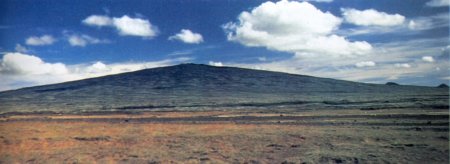shield volcano

Shield volcano in Iceland.
A shield volcano is a broad volcanic cone with gentle slopes constructed of successive nonviscous, lava flows. Shield volcanoes are usually composed of basalt. Small shield volcanoes may form rapidly from almost continuous eruptions. Large shield volcanoes may be formed by hundreds of thousands of effusive eruptions of fluid lavas from volcanic summits and rift zones. Shield volcano slopes are gentle and seldom exceed 6 degrees. The summits, which are nearly flat, are frequently indented by cliff-walled craters or calderas.
Mauna Loa volcano on the island of Hawai'i is the largest volcano on Earth. With an elevation of 4,170 meters above sea level, its long submarine flanks descend to the sea floor an additional 5 kilometers, and the sea floor in turn is depressed by Mauna Loa's great mass another 8 km. This makes the volcano's summit about 17 kilometers (56,000 feet) above its base. The volcano is constructed of an estimated 80,000 cubic kilometersof basalt. Of the 1,511 volcanoes known to have erupted in the past 10,000 years, 164 are shield volcanoes.
Lava tubes are essential for building broad shield volcanoes, because they permit lava to travel great distances from an erupting vent. For example, geologists estimate that as much as 58% of Kilauea volcano is covered with lava fed from lava tubes.
Shield volcanoes generate some of Earth's largest landslides. A landslide from East Moloka'i Volcano on Moloka'i Island had a volume of about 500 km3 and slid at least 120 kilometers across the ocean floor.
One of the largest known volcanoes in our solar system, Olympus Mons on Mars, is a shield volcano.


